Last Updated on February 9, 2023 by Devour Tours | Published: April 27, 2020
With so much to history, culture, and incredible food to be found in Spain’s capital city, it’s easy to get overwhelmed. But as you’ll find out, the vast majority of its must-see sites are located smack dab in the center.
They’re perfectly walkable from one another—which means a self-guided walking tour of Madrid is the perfect way to get to know this incredible city.
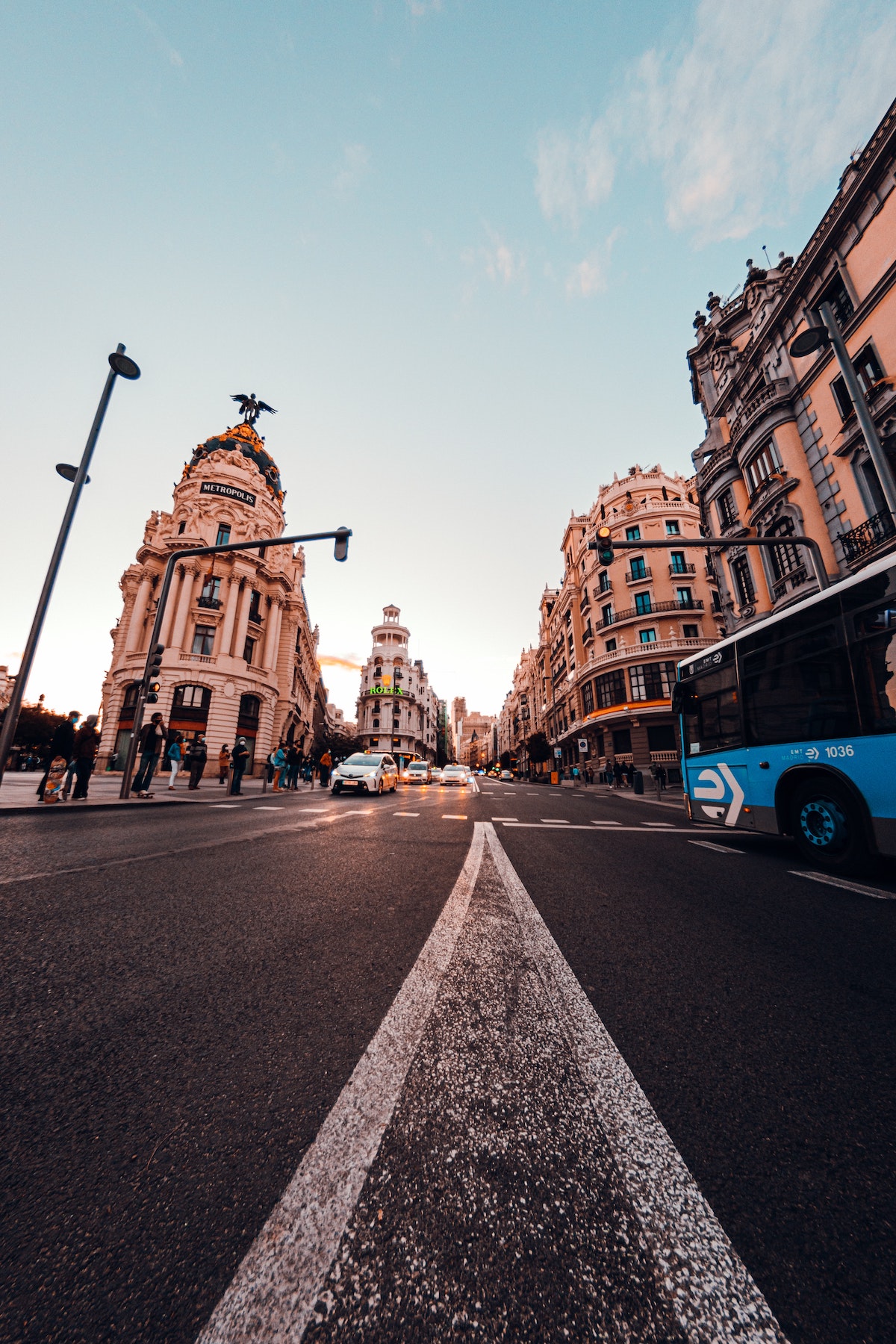
This self-guided walking tour of Madrid combines the best of both worlds: the iconic, can’t-miss sites, plus the most delicious and emblematic madrileño dishes and drinks to sample along the way.
Let’s get going!
1. Food Stop: Pastries at La Mallorquina
You’re in for a long day of exploring, and you’ll want to fuel up before you get started. There’s no better place to do this than La Mallorquina, an iconic Madrid institution right in the center of the city.
La Mallorquina has been baking up Madrid’s favorite pastries since 1894. They’re known for their napolitana de chocolate, a to-die-for, flaky, buttery, chocolate-filled pastry that makes for the sweetest and most satisfying breakfast.
You can either take your pastry to go, enjoy it at the bar or take it to the upstairs parlor if you’d rather sit down.
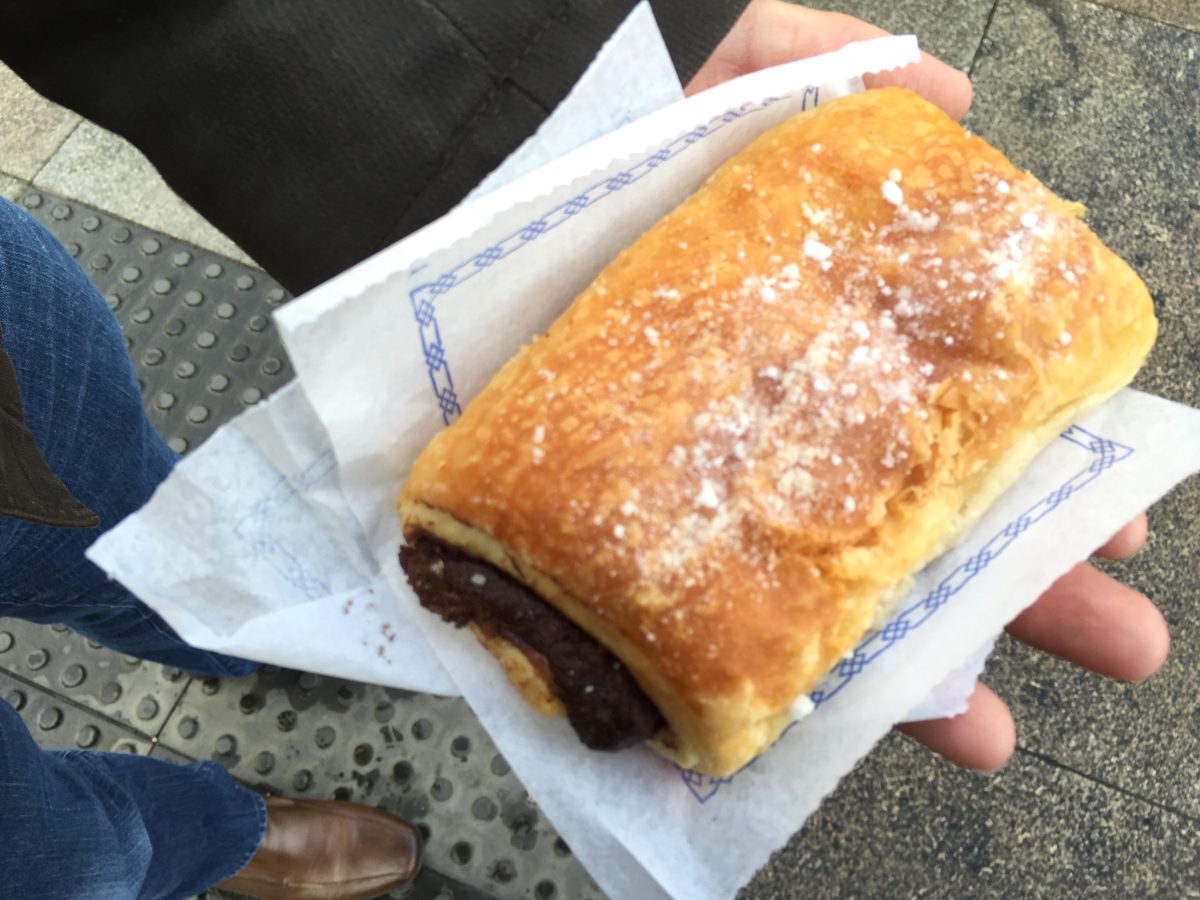
Now let’s go see some sights!
2. Puerta del Sol
As you leave the bakery, take a moment to drink in the sights and sounds of bustling Puerta del Sol, Madrid’s most vibrant and thriving square.
There’s a lot to take in here, but a few highlights are:
- The neon “Tio Pepe” sign advertising González Byass sherry, which dates from the 1930s. City regulations in recent decades have prohibited advertising signs and billboards in the square so as not to distract from the beautiful architecture. However, an exception was made for this one after madrileños fought to keep it.
- The statue of King Charles III on horseback in the center of the plaza, as well as that of a bear eating from a strawberry tree (a symbol of Madrid) on the eastern side of the square.
- The geographic center of Spain, marked by the Kilometer 0 plaque on the sidewalk in front of the Real Casa de Correos clock tower building.
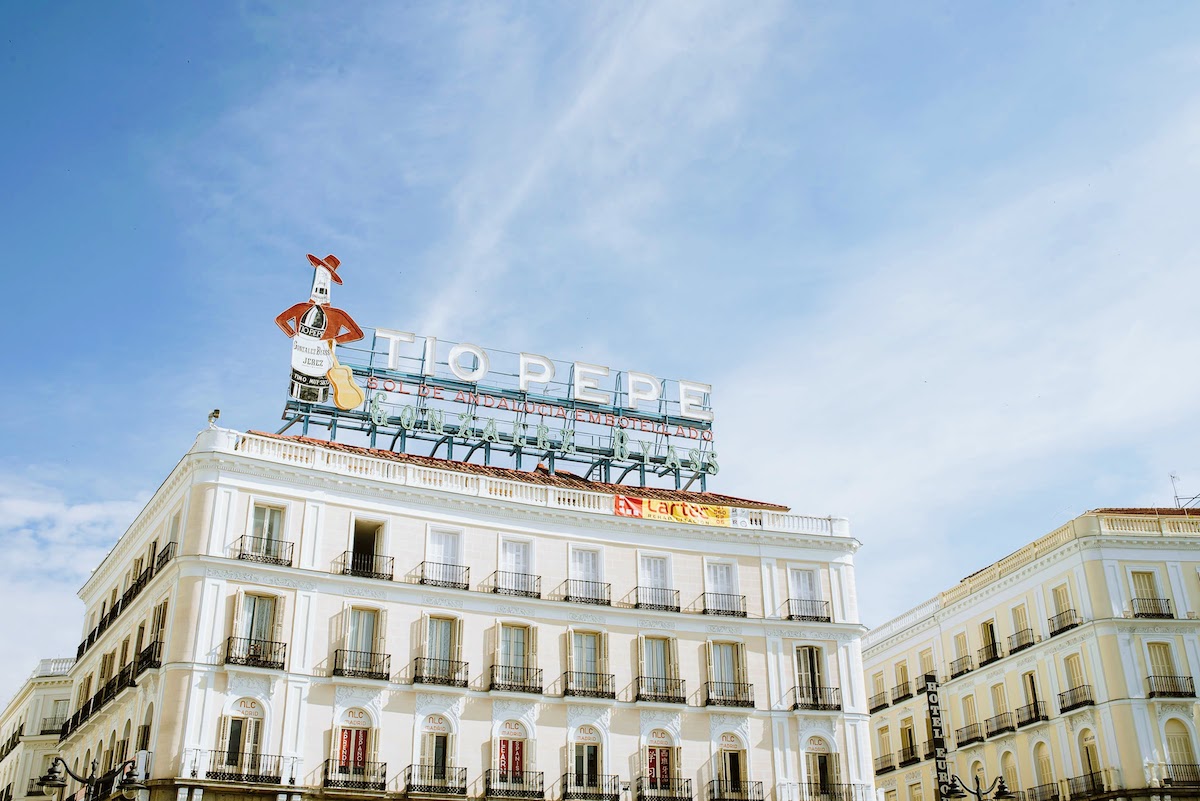
From Sol, head west down Calle Arenal toward the Royal Palace. On the way, you’ll pass by Plaza de Isabel II, where you’ll find the Teatro Real (royal opera house). Just on the other side of that, you’ll come to our next stop!
3. Plaza del Oriente
This big, beautiful plaza consists of a series of small gardens, with a giant equestrian statue and fountain as the focal point. The statue is of King Philip IV, one of the last Hapsburg kings of Spain, who wanted to show off with an elaborate and one-of-a-kind statue.
At the time, a statue of a man on horseback with the horse’s two front legs reared up had never been done before. The sculptor in charge, Pietro Tacca, was so perplexed by the challenge that he wrote to a trusted friend of his, Galileo Galilei, who was on house arrest at the time. He agreed to help—so now we have this statue thanks to Galileo himself!
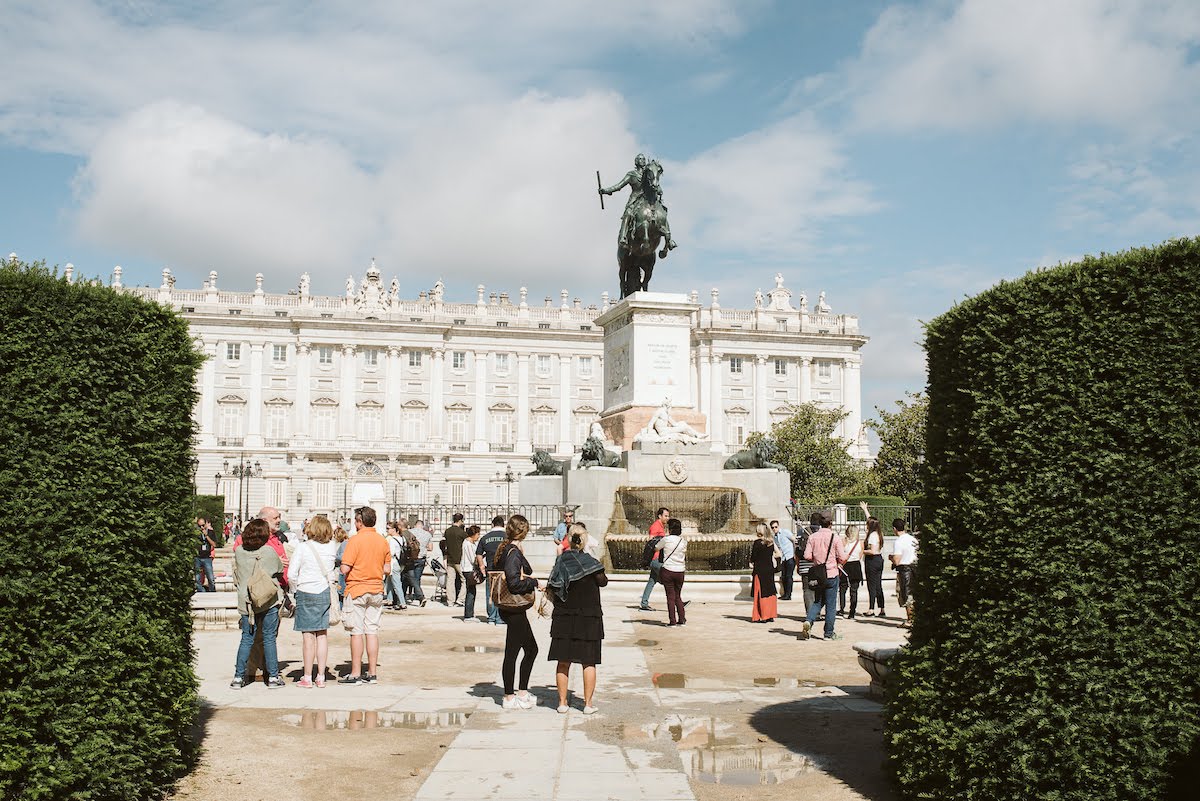
Continue past the statue toward the palace, turn left and go down Calle Bailén until you come to Plaza de la Armería between the palace and the cathedral.
4. The Royal Palace
Madrid’s Palacio Real is the largest still-functioning palace in the Western world, with approximately 2,800 rooms. The king and queen don’t actually live here, but this is where they host official events and welcome important figures. You can always tell when they’re at the palace, because a red flag will be flying right beside the Spanish flag.
The structure you see today isn’t the original palace. That building mysteriously burned down in 1734, and the one that was rebuilt was modeled after Versailles, as the first Bourbon King to ascend to the Spanish throne had grown up in the famous French palace.
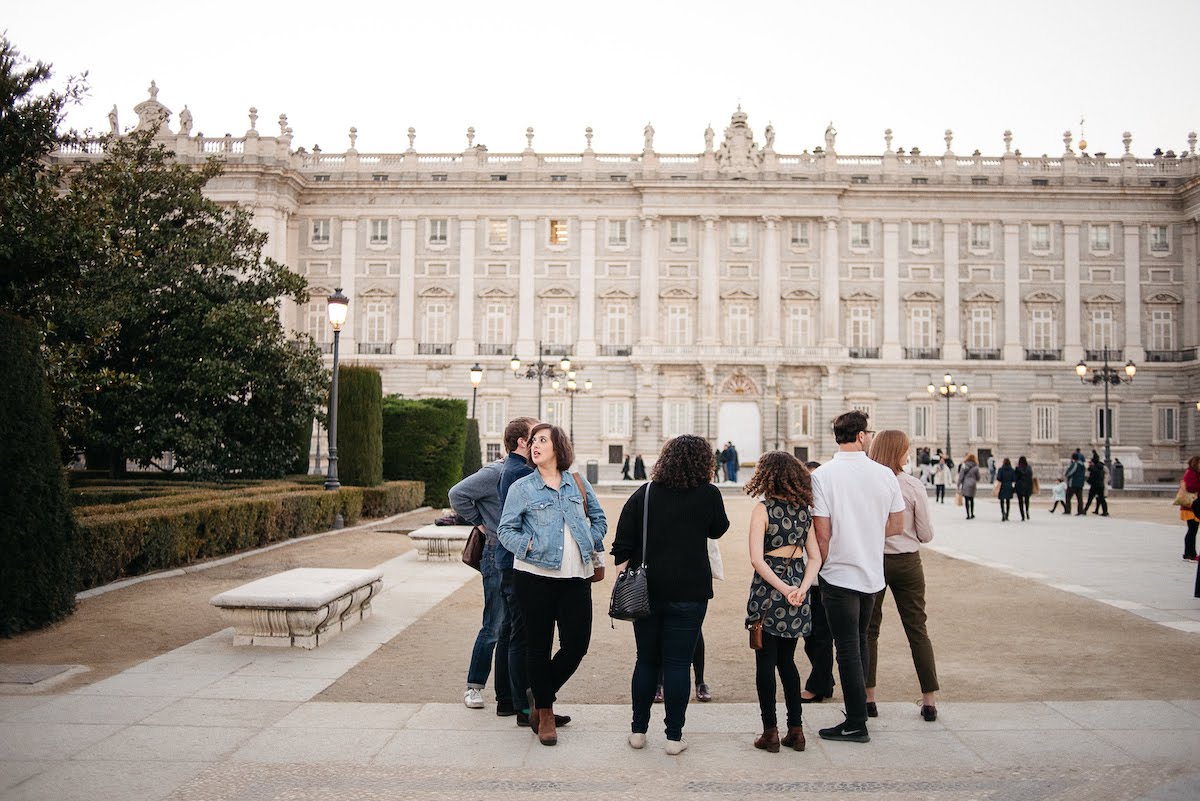
5. Almudena Cathedral
This cathedral, located across from the palace, is dedicated to La Almudena, one of the patron saints of Madrid. While the building may look quite old, it actually wasn’t finished until 1993, after 114 years of construction!
Because it took so long to build, it has two totally different styles; the exterior is neoclassical and the interior is Gothic Revival.
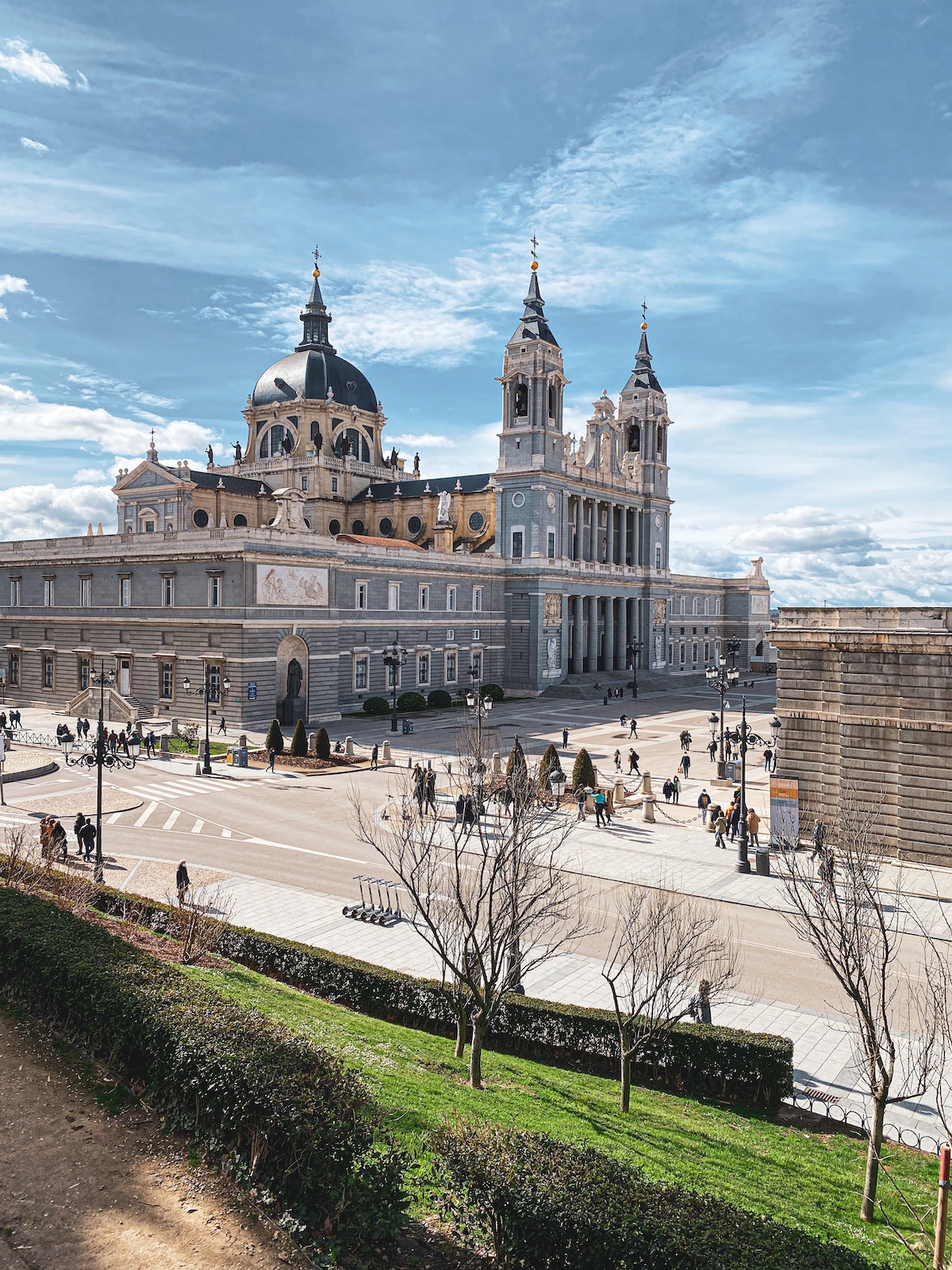
Insider’s tip: Backtrack a few steps to the stairs that lead to Calle del Factor. This beautiful little back street provides an incredible panoramic view of the palace, the cathedral and Casa de Campo, the King’s personal hunting grounds turned public park.
From the cathedral, start heading east down Calle Mayor to continue along your self-guided walking tour of Madrid.
6. Plaza de la Villa
Believe it or not, this quaint plaza was Madrid’s central city square at the height of the Spanish Empire!
Being in this plaza is like stepping back in time. Here you can find the oldest standing building in Madrid, Casa y Torre de los Lujanes, which pays tribute to Spain’s Moorish past.
The building at the back of the plaza was built shortly after Madrid became the capital of Spain in 1561, and the building on the right served as City Hall until 2007! It was built by the Hapsburgs, which explains its Austrian style.
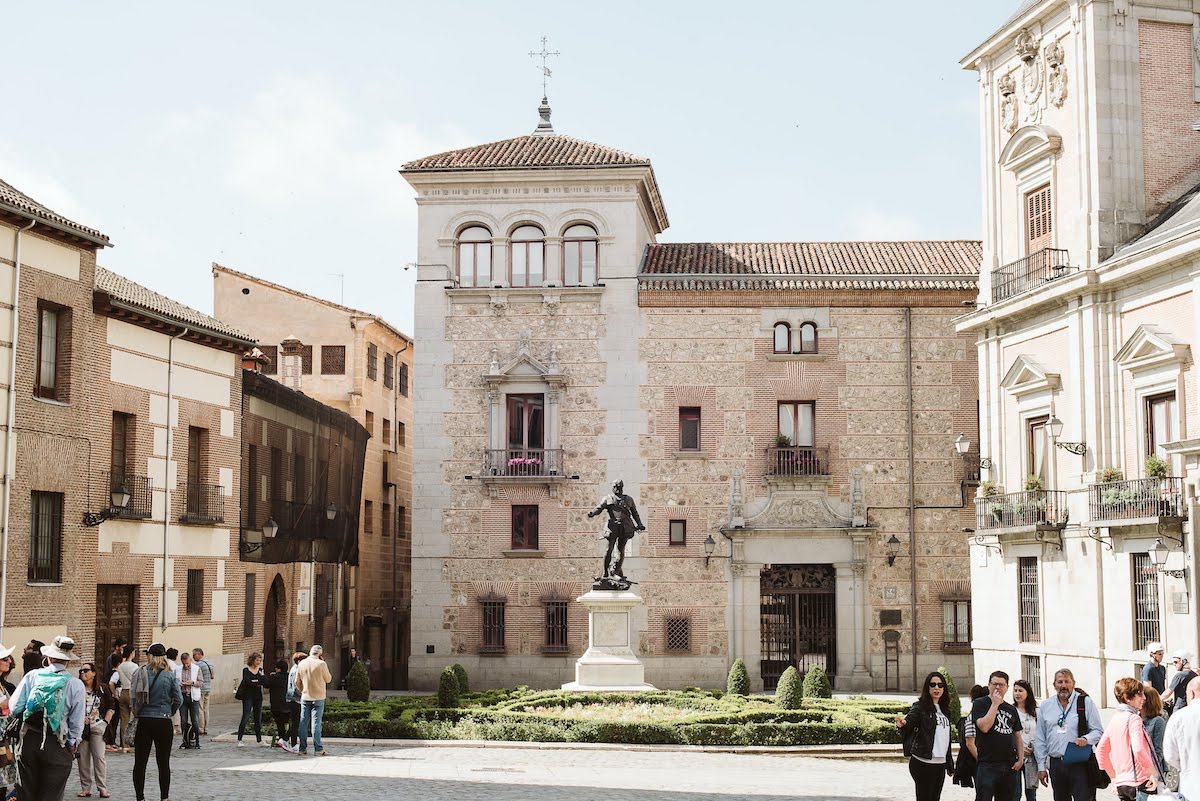
Insider’s tip: Plaza de la Villa is one of Madrid’s best hidden gems any time of day, but it’s especially beautiful when it’s empty and illuminated at night.
From the eastern side of the square, continue down Calle del Codo, which is called “elbow street” due to its shape.
7. Food Stop: Secret Sweets at Convento de las Carboneras
It’s easy to miss this place’s door, but once you find it, you won’t be disappointed!
The building housing the Convento de las Carboneras dates back to the early 17th century. The cloistered nuns that live here, like many others in Spain, have a longstanding tradition of baking and selling cookies to the public.
Here’s the twist: since they’re cloistered, you buy the cookies without having any physical contact with them. It’s a very curious and unique experience—you’ll have to visit to see for yourself! Get the pastas de almendra if available; they’re delicious!
Note: The convent is open from 9 a.m.–1 p.m. and from 4–6 p.m.
After you’ve gotten your sweets, continue your self-guided walking tour of Madrid! Walk toward Plaza Mayor via Plaza Conde de Barajas.
8. Plaza Mayor
This bustling central plaza was constructed in 1619. It’s seen its fair share of action over the years as the site of bullfights, operas and markets. During the Spanish Inquisition, up to 50,000 people used to gather here to watch public trials!
Today it’s a touristic focal point; here you can find the Tourism Office as well as a wide variety of souvenir shops and eateries.
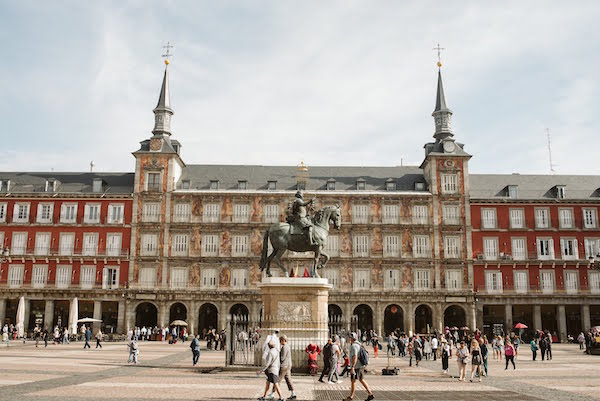
9. Food Stop: Fried Calamari Sandwich at La Campana
While Plaza Mayor is lined with restaurants, we wouldn’t recommend having a meal here. However, there is one thing that can’t be missed: the bocadillo de calamares, or fried squid sandwich.
Nearly every bar on the plaza sells them, but our favorite comes from La Campana (Calle de Botoneras, 6), a little hole-in-the-wall on a nearby side street just off the square. No tour of Madrid is complete without sampling this specialty!
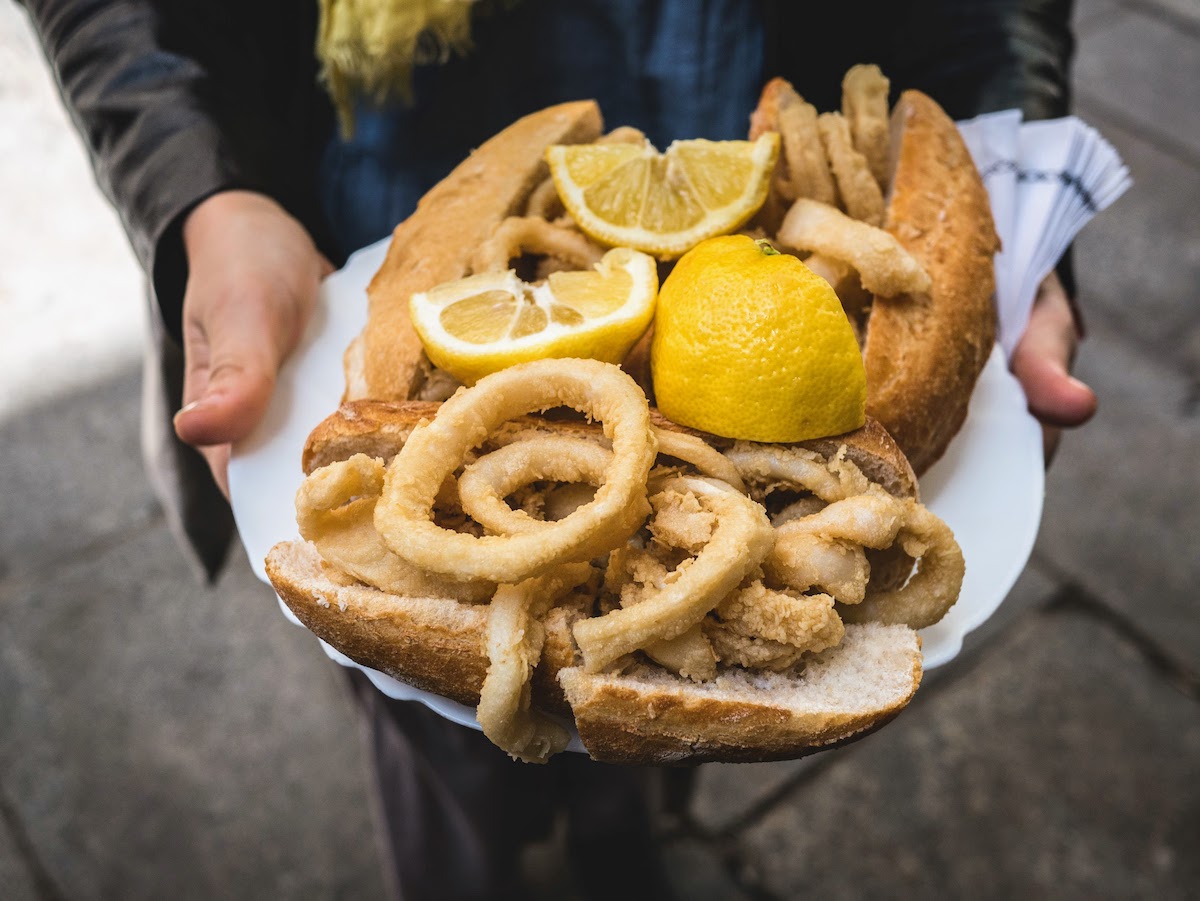
Heading away from Plaza Mayor, follow Calle de la Bolsa to Plaza de Jacinto Benavente, then continue on to Plaza de Santa Ana.
10. Plaza de Santa Ana
Plaza de Santa Ana is the gateway to the neighborhood of Huertas, also known as Barrio de Las Letras, or the Literary Quarter. For the last 400 years, Spain’s greatest literary figures and artists have roamed these very streets.
You’ll find quotes from these figures engraved below your feet, streets named in their honor, and the homes of the authors and artists themselves. The most famous resident of Huertas was Miguel de Cervantes, author of Don Quijote de la Mancha. He lived in four different apartments in the neighborhood, and is even buried here!
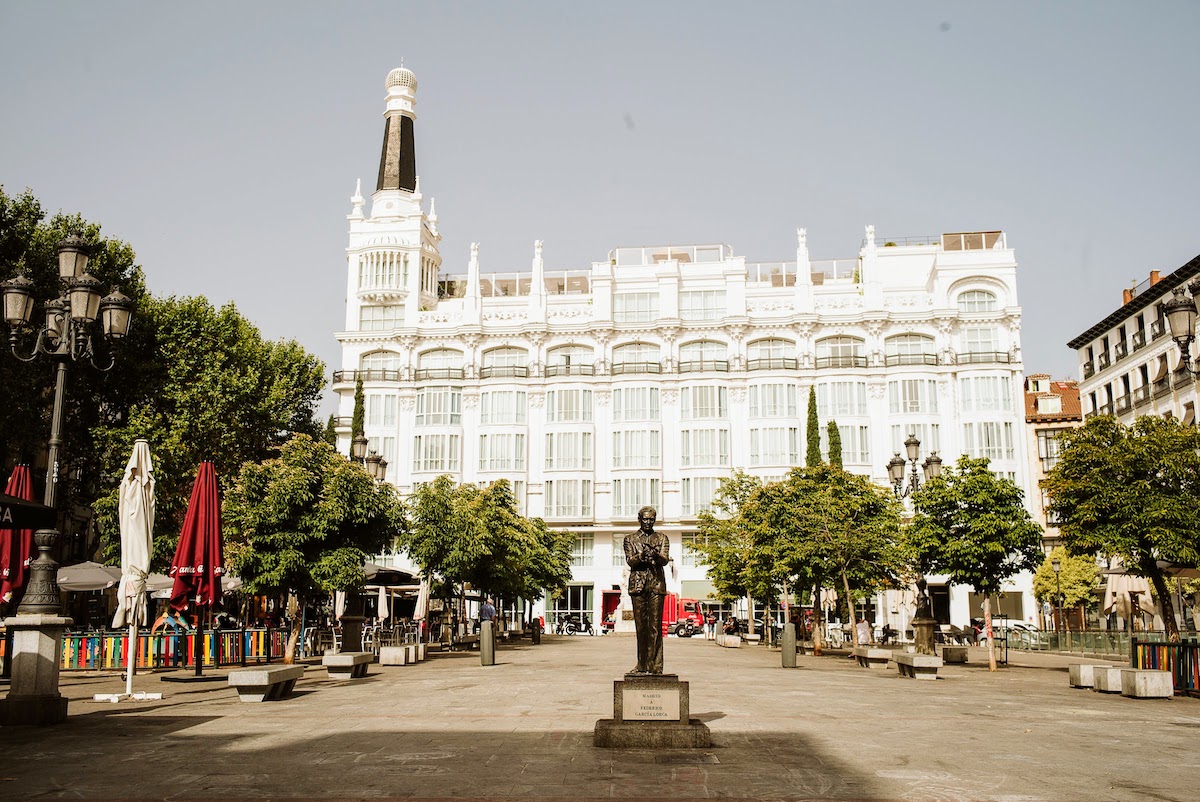
Insider’s tip: Take your time in this area, as it’s full of trendy boutiques, galleries, flamenco shops, cafes and bars. And if you’re looking for local products to take home, try Real Fábrica Española. Our advice is to get lost exploring!
Make your way to Calle de Cervantes, and follow the street to the end until you reach Calle de Jesús.
11. Food Stop: Tapas & Tostas at Taberna La Dolores, Cervecería Cervantes, or Los Gatos
After all that walking, it’s time for a well-deserved caña: a small, expertly poured draft beer. This street is famous for tapas bars like La Dolores, many of which specialize in tostas!
A tosta is simply a piece of bread with something on top. It’s the ultimate finger food, and perfect to enjoy right at the bar. Take a look at what they’ve got on display, or just ask the bartender for a recommendation! Their boquerones en vinagre, or marinated anchovies, are great as well.
If you want to have an authentic “tapeo” and jump from bar to bar, check out nearby favorites like Cervecería Cervantes and Los Gatos.
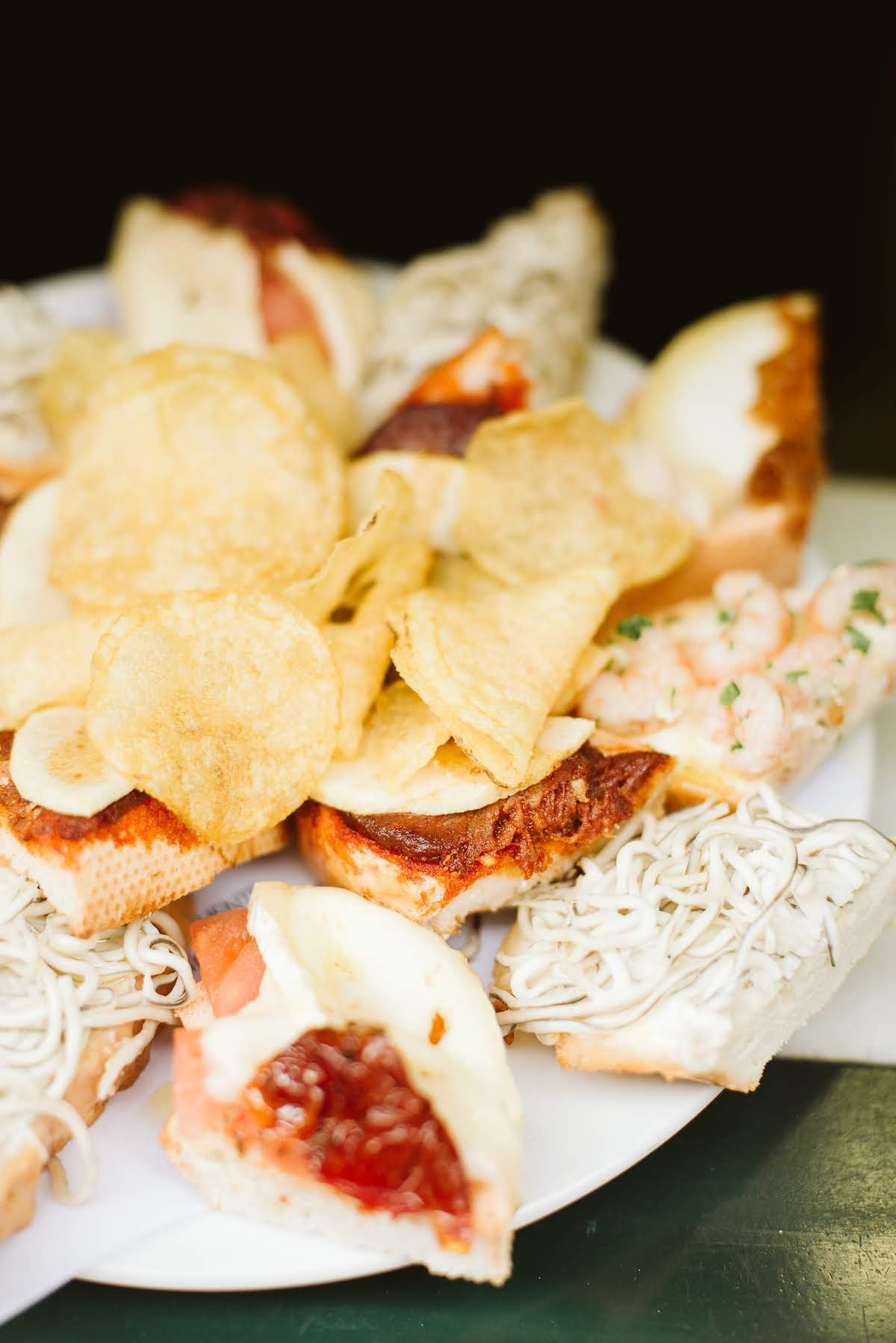
Walk through Huertas and cross Paseo del Prado. You’ll finish your self-guided walking tour of Madrid at the city’s most iconic park, passing by the world-famous Prado Museum on the way.
12. Retiro Park
Last but certainly not least is El Parque del Buen Retiro. This gorgeous, manicured park is the perfect place to sit down and relax after a long day of exploring. Find a spot in the sun, break open those nuns’ cookies and watch the world go by.
While you’re here, be sure to visit:
- La Rosaleda, a beautiful rose garden with over 4,000 roses
- Los Jardines de Cecilio Rodríguez, a hidden garden in the back end of the park filled with families of peacocks
- Of course, the central lake where you can rent a rowboat… or just sit and enjoy a coffee or caña at one of the surrounding cafes.
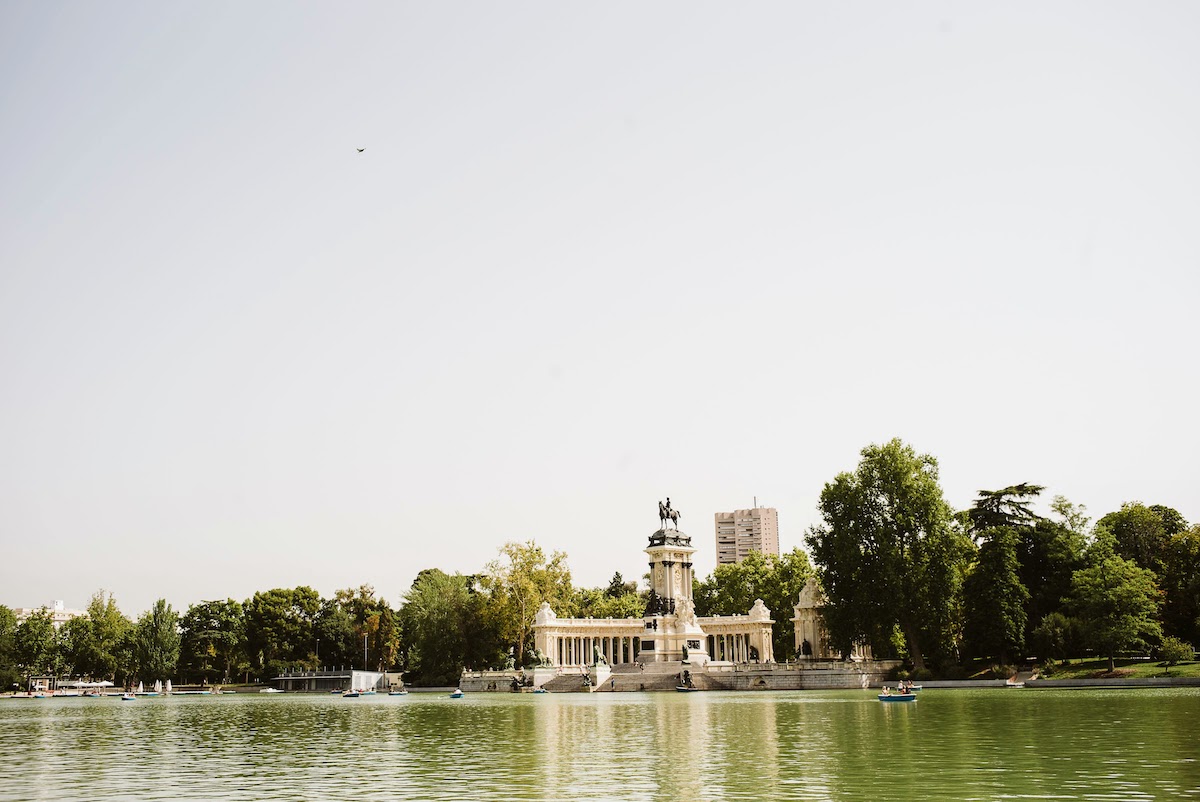
Self Guided Walking Tour of Madrid FAQs
Indeed it is—in fact, that’s the best way to experience the city! Most of the city’s iconic sites are within walking distance of each other, and the main roads and plazas are easy to navigate around as well.
Madrid is overall an incredibly safe city, and violent crime rates are very low. However, petty crime like pickpocketing is quite common in crowded areas, such as Puerta del Sol. Be vigilant and always keep an eye on your belongings as you make your way around town.
Madrid’s main commercial drag is Gran Via, just north of Puerta del Sol and west of Retiro Park. It’s packed with big-name fashion brands, restaurants and bars, theaters, and so much more.
Update Notice: This post was updated on March 29, 2021.
Want to upgrade your experience by exploring Madrid alongside an expert guide? Join our Madrid in a Day with Royal Palace, Churros Tasting, and Prado Museum Tour to discover local secrets and sample more of the city’s best bites!
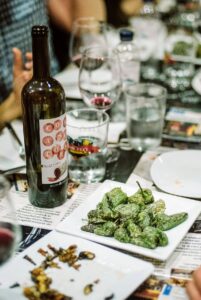
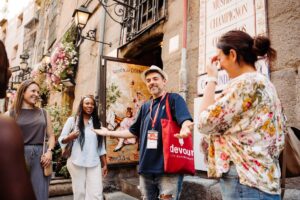
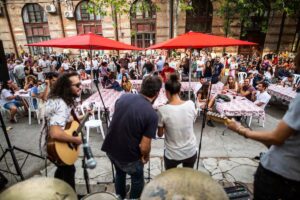






Wow what an amazing places of Madrid. Thanks for sharing this post.
Glad you enjoyed it, John! Thanks for reading.